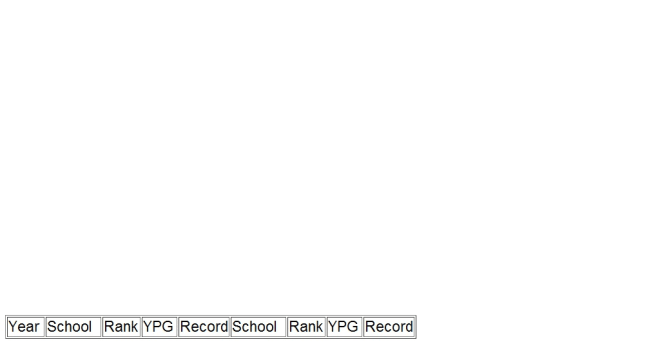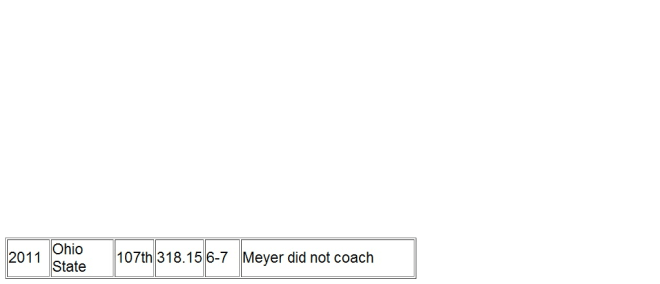Numbers dont lie
class="st_facebook_hcount" displayText="Share">
displayText="Email">
Advertisement

KyleRowland">Rowland | Givler | Birmingham
COLUMBUS, Ohio - During the 2011 footballs season the Ohio State offense ranked No. 107 out of 120 schools in total offense and most Buckeye fans would call shenanigans that there were 13 offenses that ranked lower (Only one team, Utah, had a winning record with a lower ranked offense in total offense).
There will be several new faces on the offense in 2012 but the 'core' group of players are still there even with the graduation of DeVier Posey, Dan Herron, Mike Adams, Michael Brewster and J.B. Shugarts.
Ohio State led the nation in spring game attendance for 2012 with more than 80-thousand fans packing Ohio Stadium to get a glimpse of what the new-look Buckeyes may look like. But new head coach Urban Meyer admitted before the spring game that fans (and media) would not be looking at what the offense would look like when the games count in September and that the team needed to focus on throwing the ball and seeing who can catch the ball.
Both quarterbacks, Braxton Miller and Kenny Guiton had plenty of opportunity to sling the ball around and freshman wide receiver Michael Thomas hauled in 12 receptions, just receptions less than what would have tied for the lead on the team in 2011.
But Meyer's track record will promise a much more prolific offense than what Buckeye fans have been used to seeing in years past. Meyer's offenses have ranked nationally in the top-20 six seasons since 2001 where the Buckeyes have only been in the top-20 one season (2010).
While total offense will not always predict the success of a team throughout the season (Ohio State won the 2002 National Championship with the No. 70 ranked total offense nationally) it is still a good indicator of success and if the Ohio State offense is ever able to catch up to the numbers that the Ohio State defense has put up in past years, the sky could be the limit in Columbus.



Highlighted years denotes BCS Championship
Ultimately it is going to be the team that puts the most points on the board that is going to win and under Meyer's offense his teams have been able to do that with great success, year in and year out.
His first two teams at Bowling Green were able to run up the score in the Mid-American Conference with the 2001 Falcon team scoring 30 points per game and his 2002 team scoring 40.8 points per game which was good enough for 3rd nationally.
That trend continued when Meyer moved to Utah where his Utes team scored 29 points per game during his first season and then during Meyer's undefeated season the team scored 45.3 points per game to rank 3rd nationally once again.
Scoring like that in the mid-majors is one thing but when Meyer made the leap to Florida and the Southeastern Conference, things did not let up. He had two teams (2007 and 2008) each break the 40 point per game plateau once again ('07 - 42.4, '08 - 43.6). Even his 2009 season saw his team break the 35 point mark per game. Strangely enough his 2006 National Championship team averaged fewer points than his final season in Gainesville (Fla.) by a slim margin and Meyer's lowest scoring team with the Gators averaged 28.58 points per contest.
Just for the sake of comparison, Ohio State has not averaged more than 40 points a game in a season during the timeframe that Meyer had coached and the high watermark would be the 2010 season where the team scored just shy of 39 points per game (but if you follow the NCAA record books, that year didn't happen). During that same time period, Ohio State averaged fewer points per game (than Meyer's low watermark) five seasons.
People will be quick to point out that Meyer-led teams can't get things done on the ground and there are some recruiting followers of other teams that would like to point that out to any running back that is even considering Ohio State. But the numbers will show that four of Meyer's ten teams have ranked in the top-15 nationally in rushing. Meyer saw his 2002 Bowling Green team rank 11th (219.0), his 2004 Utah team rank 13th (236.0) and a pair of teams at Florida come in at 10th (2008 - 231.1, 2010 - 221.7).
Even more mind-blowing is the fact that during Meyer's six years at Florida that the Gators totaled more rushing yards than any other team in the league.
SEC Cumulative Rushing Yards 2005-10)
1. Florida 15,109 (185 TDs via the ground)
2. Auburn 14,654 (149)
3. Arkansas 14,320 (136)
4. LSU 13,282 (152)
5. Alabama 13,224 (134)
During that same time period the Gators, under Meyer, ranked 2nd in the SEC in passing yard only to South Carolina and led the league in passing touchdowns with 154.
One criticism that Ohio State fans have had about the way that the Buckeyes won games during the past decade is the margin of victory. Granted, the Buckeyes won a lot during that time but there were plenty of nail biters that likely didn't need to come down to the wire. Nearly a third of Meyer's wins (32 of 104) have been decided by 30-or-more-points and 14 of those wins have been by better than 40-or-more.
And if Meyer led teams get on the board first it usually means a win for his team with an overall record of 76-5 when scoring first and 49-2 while he was with the Gators.
Finally, by the numbers:
4 The number of times Urban Meyer's teams have had a Top 5 scoring average nationally
14 Number of times Meyer's teams have ranked among the Top 10 nationally in an offensive statistical category
17 Number of times a Meyer-coached team has led its conference in an offensive statistical category
23 Number of times Meyer's teams have scored 50-or-more points in a game
35.5 The average number of points per game by Meyer's teams
45.3 The highest per game scoring average for a season for one of Meyer's teams (2004 Utah)
53 Number of times Meyer's teams have scored 40-or-more points in a game.
Thanks to Ohio State Athletic Communications with statistical research assistance for this piece
[rl]